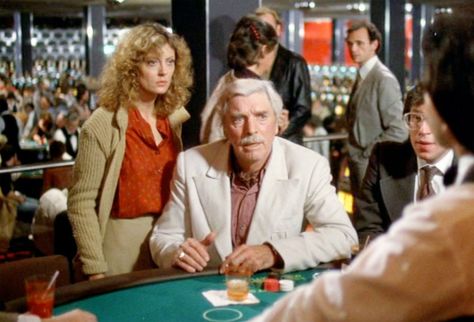By Dennis Hartley
(Originally posted on Digby’s Hullabaloo on June 20, 2020)

The artist is the medium between his fantasies and the rest of the world.
— Federico Fellini
There are few tougher sells to moviegoers than a film that simmers in the navel-gazing angst of a creatively blocked filmmaker. Yet it has become a venerable sub-genre you can trace at least as far back as Preston Sturges’ 1941 satire Sullivan’s Travels. Joel McCrea plays a director of populist comedies who yearns to make a “meaningful” film. Racked with guilt about the comfortable bubble that his Hollywood success has afforded him and determined to learn firsthand how the other half lives, he hits the road masquerading as a penniless railroad tramp. His crash-course in “social realism” becomes more than he bargained for. What did he expect? I mean, talk about “bitching in Paradise”…am I right?
As I noted in my 2013 review of Paolo Sorrentino’s La grande bellezza (aka The Great Beauty), a drama regarding an acclaimed novelist who is weathering an existential crisis:
Sorrentino’s film left me ambivalent. Interestingly, it was very similar to the way I felt in the wake of Eat Pray Love. In my review of that film, I relayed my inability to empathize with what I referred to as the “Pottery Barn angst” on display. It’s that plaintive wail of the 1%: “I’ve got it all, and I’ve done it all and seen it all, but something’s missing…oh, the humanity!” It’s not that I don’t understand our protagonist’s belated pursuit of truth and beauty; it’s just that Sorrentino fails to make me care enough to make me want to tag long on this noble quest for 2 hours, 22 minutes.
While The Great Beauty is not about a film maker, it is nonetheless a direct descendant of Federico Fellini’s 8½. Fellini’s 1963 drama about a creatively blocked director stewing over his next project offered a groundbreaking take on the “blocked artist” trope. With a non-linear narrative and flights of fantasy, it injected the “metaphysical” into the “meta”.
It was outrageously over-the-top and completely self-indulgent (especially for 1963), but Fellini’s film managed to strike a chord with audiences and critics. That is not an easy trick to pull off. In a 2000 retrospective on the film, Roger Ebert offered this explanation:
Fellini is a magician who discusses, reveals, explains and deconstructs his tricks, while still fooling us with them. He claims he doesn’t know what he wants or how to achieve it, and the film proves he knows exactly, and rejoices in his knowledge.
It also was (and remains) a hugely influential work. Films like Paul Mazursky’s Alex in Wonderland (1970), Francois Truffaut’s Day for Night (1973), and Woody Allen’s Stardust Memories (1980) are a few of the more notable works with strong echoes of 8½.
Writer-director Abel Ferrara’s Tommaso [now playing nationally in virtual cinemas via Kino Marquee] is the latest descendant of 8½; although it offers a less fanciful and decidedly more fulminating portrait of a creative artist in crisis. The film’s star (and frequent Ferrara collaborator) Willem Dafoe is certainly no stranger to inhabiting deeply troubled characters; and his “Tommaso” is (to say the least) a troubled, troubled man.
Tommaso is a 60-something American ex-pat film maker who lives in Rome with his 29 year-old Italian wife Nikki (Cristina Chiriac) and 3 year-old daughter Dee Dee (Anna Ferrara). At first glance, Tommaso leads an idyllic life; he has ingratiated himself by taking Italian lessons from a private tutor and appears to be a fixture in his neighborhood, cheerfully going about his daily errands with the unhurried countenance of a native local.
However, as we are given more time to observe Tommaso’s home life, there is increasing evidence of trouble in Paradise. Aside from the classic schisms that tend to occur in May-December relationships, Tommaso and Nikki obviously struggle with some cultural differences. Tommaso is also on edge because he is working on a storyboard for his next film (with elements that recall The Revenant) but can’t decide what he wants it to “say”.
The angst really kicks in when Tommaso attends an AA meeting. And then another, and another. While these scenes (i.e. monologues) are somewhat static and are potential deal-breakers for some viewers, they are key in communicating Tommaso’s inner turmoil.
Of course, the question becomes…do you care? Is this all just more of that “Pottery Barn angst” that I mentioned earlier? Dude…you have a beautiful young wife and an adorable little girl, you’re slumming in Rome, you’re an artist who makes his own schedule…and all you do is whinge and moan about how your life sucks, meow-meow woof-woof. Oh, please!
On the other hand, keep in mind this is an Abel Ferrara film. Historically, Ferrara does not churn out “light” fare. If you have seen China Girl, Ms .45, Bad Lieutenant, King of New York, The Addiction, The Funeral, 4:44 Last Day on Earth, et.al.-you know he is a visceral and uncompromising filmmaker. What I’m suggesting is, don’t give up on this too early; stay with it, give it some time to stew (I confess- it took me two viewings to “get there”).
The main impetus for sticking with the film (which ultimately shares more commonalities with Bernardo Bertolucci’s Last Tango in Paris and Terrence Malick’s The Tree of Life than with 8½) is to savor Dafoe’s carefully constructed performance. Handed the right material, he can be a force of nature; and here, Ferrara hands Dafoe precisely the right material.










